Sainsbury's: Cross-Cultural Analysis and Market Entry Strategy
VerifiedAdded on 2023/01/05
|13
|3599
|33
Report
AI Summary
This report delves into the cross-cultural analysis of Sainsbury's, a UK-based supermarket chain, focusing on its potential expansion into the Indian market. The analysis begins with an introduction to cross-cultural concepts and their importance in international business, particularly in an era of globalization. The main body of the report examines the application of Hofstede's cultural dimensions to compare the UK and India, highlighting differences in power distance, individualism, masculinity, uncertainty avoidance, and long-term orientation. These differences inform the development of a suitable marketing mix for Sainsbury's in India, considering product adaptations (e.g., offering ethnic wear), pricing strategies (e.g., catering to the middle class), promotional methods (e.g., using TV and social media), placement of stores, and process considerations. The report also addresses the importance of hiring and retaining employees from the Indian market, emphasizing a centralized operational structure for effective management. The report concludes with a summary of the key findings and recommendations for Sainsbury's successful market entry into India.
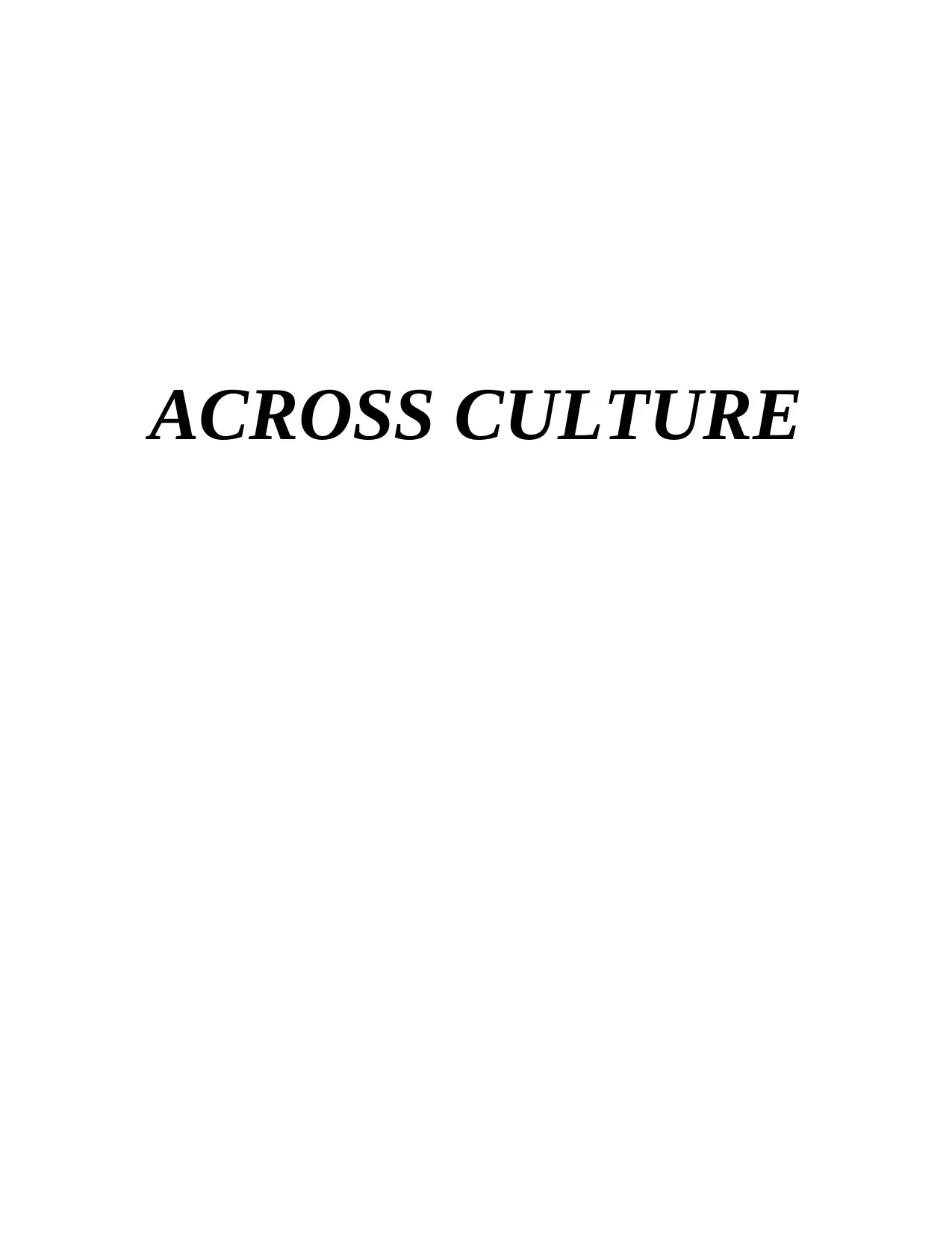
ACROSS CULTURE
Paraphrase This Document
Need a fresh take? Get an instant paraphrase of this document with our AI Paraphraser
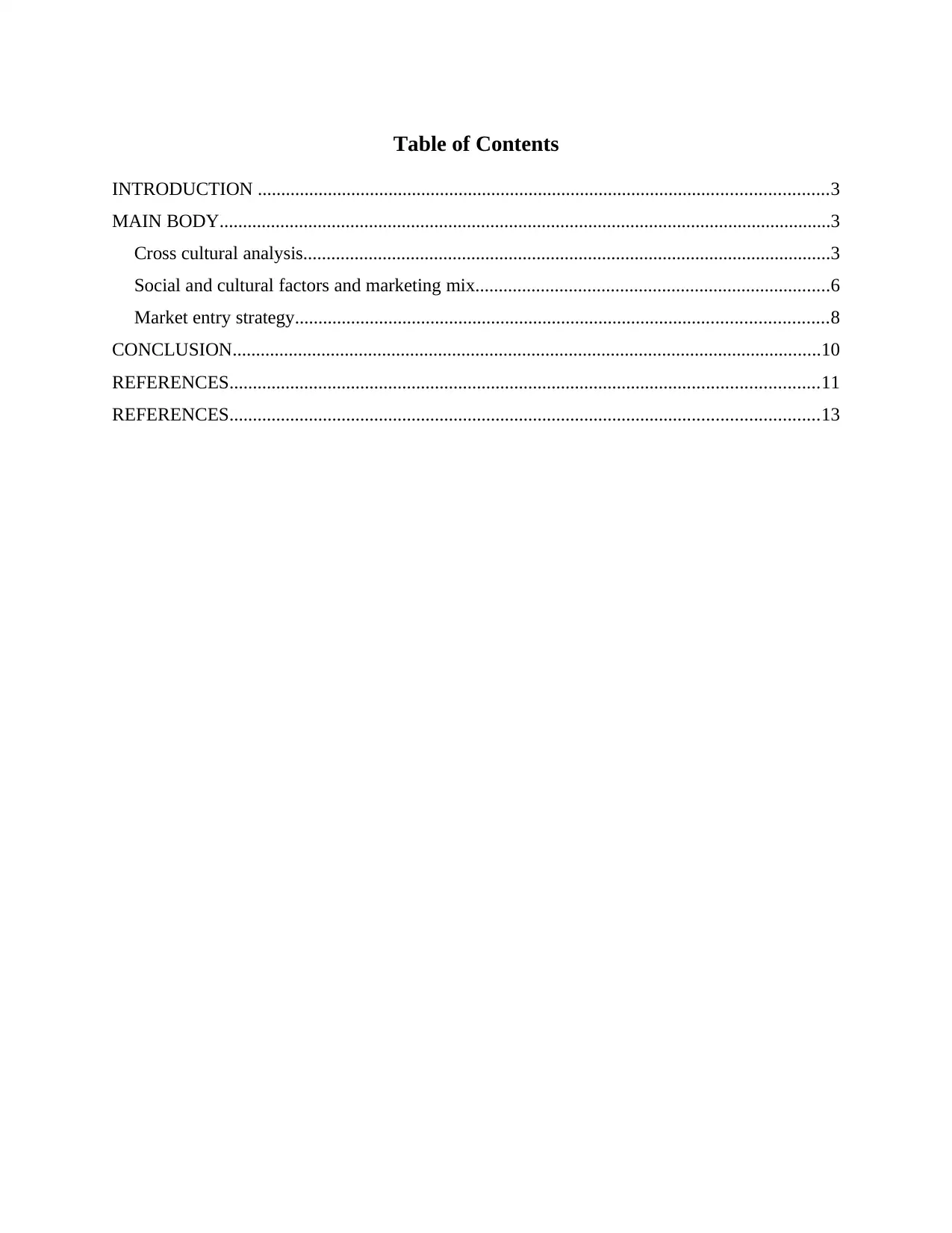
Table of Contents
INTRODUCTION ..........................................................................................................................3
MAIN BODY...................................................................................................................................3
Cross cultural analysis.................................................................................................................3
Social and cultural factors and marketing mix............................................................................6
Market entry strategy..................................................................................................................8
CONCLUSION..............................................................................................................................10
REFERENCES..............................................................................................................................11
REFERENCES..............................................................................................................................13
INTRODUCTION ..........................................................................................................................3
MAIN BODY...................................................................................................................................3
Cross cultural analysis.................................................................................................................3
Social and cultural factors and marketing mix............................................................................6
Market entry strategy..................................................................................................................8
CONCLUSION..............................................................................................................................10
REFERENCES..............................................................................................................................11
REFERENCES..............................................................................................................................13
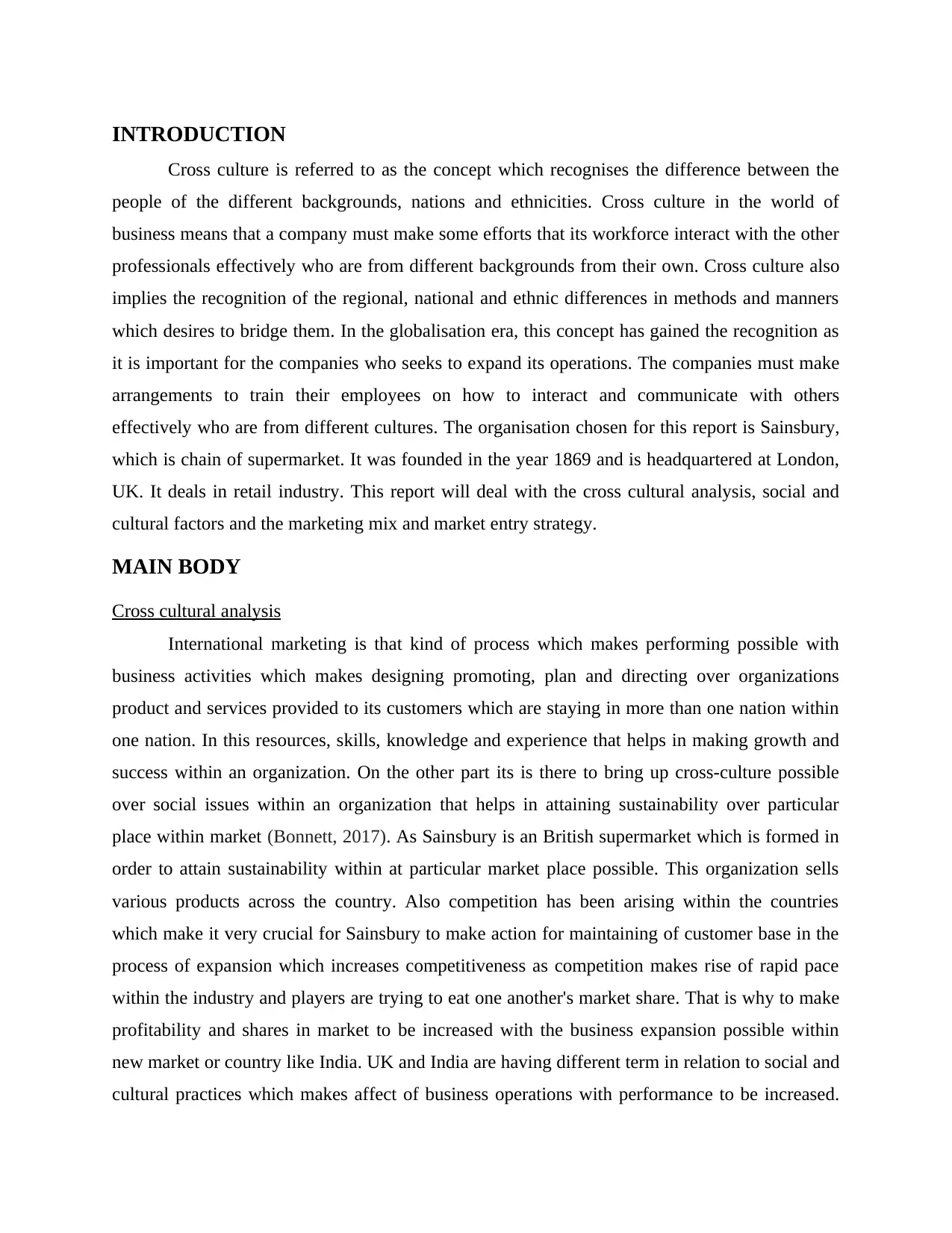
INTRODUCTION
Cross culture is referred to as the concept which recognises the difference between the
people of the different backgrounds, nations and ethnicities. Cross culture in the world of
business means that a company must make some efforts that its workforce interact with the other
professionals effectively who are from different backgrounds from their own. Cross culture also
implies the recognition of the regional, national and ethnic differences in methods and manners
which desires to bridge them. In the globalisation era, this concept has gained the recognition as
it is important for the companies who seeks to expand its operations. The companies must make
arrangements to train their employees on how to interact and communicate with others
effectively who are from different cultures. The organisation chosen for this report is Sainsbury,
which is chain of supermarket. It was founded in the year 1869 and is headquartered at London,
UK. It deals in retail industry. This report will deal with the cross cultural analysis, social and
cultural factors and the marketing mix and market entry strategy.
MAIN BODY
Cross cultural analysis
International marketing is that kind of process which makes performing possible with
business activities which makes designing promoting, plan and directing over organizations
product and services provided to its customers which are staying in more than one nation within
one nation. In this resources, skills, knowledge and experience that helps in making growth and
success within an organization. On the other part its is there to bring up cross-culture possible
over social issues within an organization that helps in attaining sustainability over particular
place within market (Bonnett, 2017). As Sainsbury is an British supermarket which is formed in
order to attain sustainability within at particular market place possible. This organization sells
various products across the country. Also competition has been arising within the countries
which make it very crucial for Sainsbury to make action for maintaining of customer base in the
process of expansion which increases competitiveness as competition makes rise of rapid pace
within the industry and players are trying to eat one another's market share. That is why to make
profitability and shares in market to be increased with the business expansion possible within
new market or country like India. UK and India are having different term in relation to social and
cultural practices which makes affect of business operations with performance to be increased.
Cross culture is referred to as the concept which recognises the difference between the
people of the different backgrounds, nations and ethnicities. Cross culture in the world of
business means that a company must make some efforts that its workforce interact with the other
professionals effectively who are from different backgrounds from their own. Cross culture also
implies the recognition of the regional, national and ethnic differences in methods and manners
which desires to bridge them. In the globalisation era, this concept has gained the recognition as
it is important for the companies who seeks to expand its operations. The companies must make
arrangements to train their employees on how to interact and communicate with others
effectively who are from different cultures. The organisation chosen for this report is Sainsbury,
which is chain of supermarket. It was founded in the year 1869 and is headquartered at London,
UK. It deals in retail industry. This report will deal with the cross cultural analysis, social and
cultural factors and the marketing mix and market entry strategy.
MAIN BODY
Cross cultural analysis
International marketing is that kind of process which makes performing possible with
business activities which makes designing promoting, plan and directing over organizations
product and services provided to its customers which are staying in more than one nation within
one nation. In this resources, skills, knowledge and experience that helps in making growth and
success within an organization. On the other part its is there to bring up cross-culture possible
over social issues within an organization that helps in attaining sustainability over particular
place within market (Bonnett, 2017). As Sainsbury is an British supermarket which is formed in
order to attain sustainability within at particular market place possible. This organization sells
various products across the country. Also competition has been arising within the countries
which make it very crucial for Sainsbury to make action for maintaining of customer base in the
process of expansion which increases competitiveness as competition makes rise of rapid pace
within the industry and players are trying to eat one another's market share. That is why to make
profitability and shares in market to be increased with the business expansion possible within
new market or country like India. UK and India are having different term in relation to social and
cultural practices which makes affect of business operations with performance to be increased.
⊘ This is a preview!⊘
Do you want full access?
Subscribe today to unlock all pages.

Trusted by 1+ million students worldwide
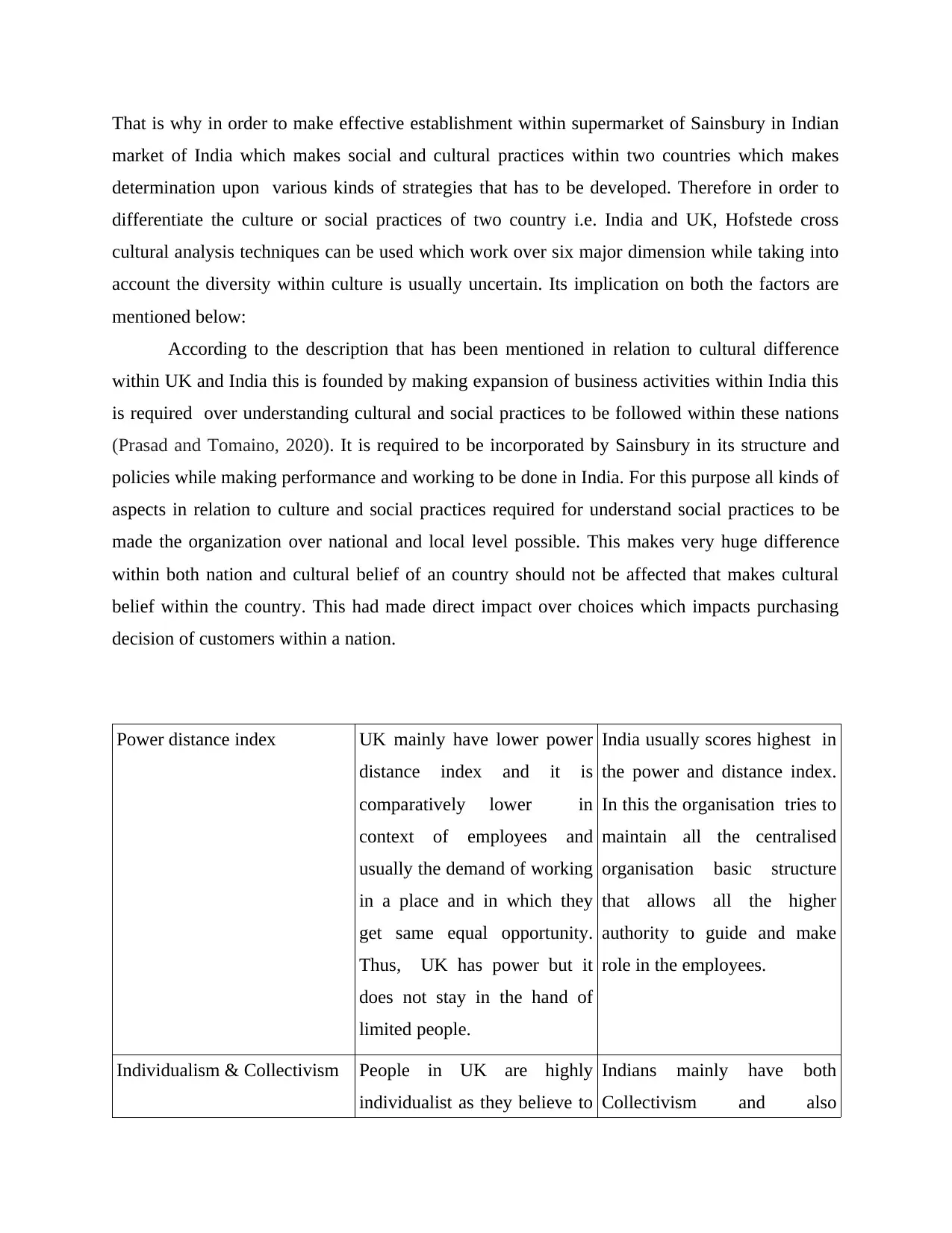
That is why in order to make effective establishment within supermarket of Sainsbury in Indian
market of India which makes social and cultural practices within two countries which makes
determination upon various kinds of strategies that has to be developed. Therefore in order to
differentiate the culture or social practices of two country i.e. India and UK, Hofstede cross
cultural analysis techniques can be used which work over six major dimension while taking into
account the diversity within culture is usually uncertain. Its implication on both the factors are
mentioned below:
According to the description that has been mentioned in relation to cultural difference
within UK and India this is founded by making expansion of business activities within India this
is required over understanding cultural and social practices to be followed within these nations
(Prasad and Tomaino, 2020). It is required to be incorporated by Sainsbury in its structure and
policies while making performance and working to be done in India. For this purpose all kinds of
aspects in relation to culture and social practices required for understand social practices to be
made the organization over national and local level possible. This makes very huge difference
within both nation and cultural belief of an country should not be affected that makes cultural
belief within the country. This had made direct impact over choices which impacts purchasing
decision of customers within a nation.
Power distance index UK mainly have lower power
distance index and it is
comparatively lower in
context of employees and
usually the demand of working
in a place and in which they
get same equal opportunity.
Thus, UK has power but it
does not stay in the hand of
limited people.
India usually scores highest in
the power and distance index.
In this the organisation tries to
maintain all the centralised
organisation basic structure
that allows all the higher
authority to guide and make
role in the employees.
Individualism & Collectivism People in UK are highly
individualist as they believe to
Indians mainly have both
Collectivism and also
market of India which makes social and cultural practices within two countries which makes
determination upon various kinds of strategies that has to be developed. Therefore in order to
differentiate the culture or social practices of two country i.e. India and UK, Hofstede cross
cultural analysis techniques can be used which work over six major dimension while taking into
account the diversity within culture is usually uncertain. Its implication on both the factors are
mentioned below:
According to the description that has been mentioned in relation to cultural difference
within UK and India this is founded by making expansion of business activities within India this
is required over understanding cultural and social practices to be followed within these nations
(Prasad and Tomaino, 2020). It is required to be incorporated by Sainsbury in its structure and
policies while making performance and working to be done in India. For this purpose all kinds of
aspects in relation to culture and social practices required for understand social practices to be
made the organization over national and local level possible. This makes very huge difference
within both nation and cultural belief of an country should not be affected that makes cultural
belief within the country. This had made direct impact over choices which impacts purchasing
decision of customers within a nation.
Power distance index UK mainly have lower power
distance index and it is
comparatively lower in
context of employees and
usually the demand of working
in a place and in which they
get same equal opportunity.
Thus, UK has power but it
does not stay in the hand of
limited people.
India usually scores highest in
the power and distance index.
In this the organisation tries to
maintain all the centralised
organisation basic structure
that allows all the higher
authority to guide and make
role in the employees.
Individualism & Collectivism People in UK are highly
individualist as they believe to
Indians mainly have both
Collectivism and also
Paraphrase This Document
Need a fresh take? Get an instant paraphrase of this document with our AI Paraphraser
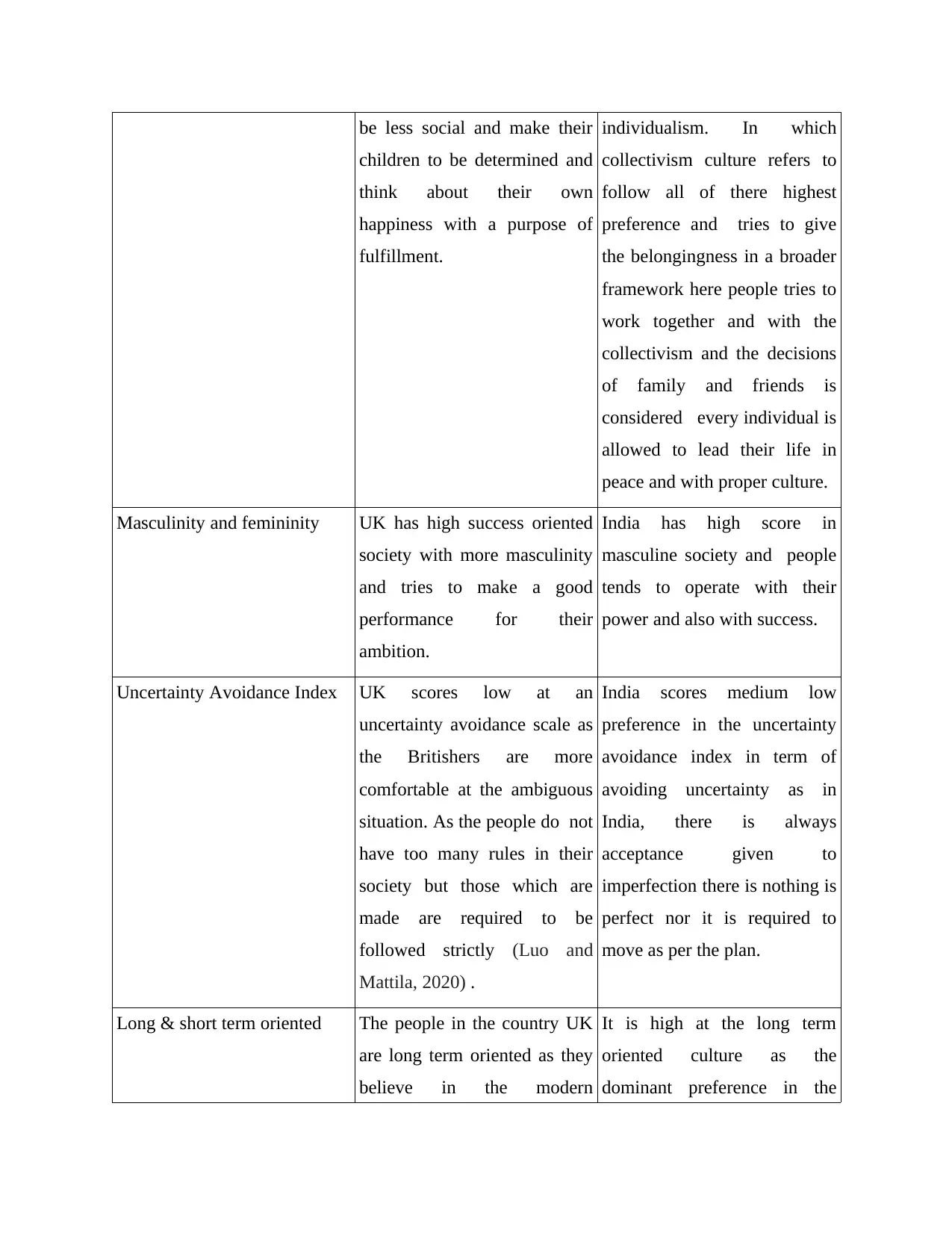
be less social and make their
children to be determined and
think about their own
happiness with a purpose of
fulfillment.
individualism. In which
collectivism culture refers to
follow all of there highest
preference and tries to give
the belongingness in a broader
framework here people tries to
work together and with the
collectivism and the decisions
of family and friends is
considered every individual is
allowed to lead their life in
peace and with proper culture.
Masculinity and femininity UK has high success oriented
society with more masculinity
and tries to make a good
performance for their
ambition.
India has high score in
masculine society and people
tends to operate with their
power and also with success.
Uncertainty Avoidance Index UK scores low at an
uncertainty avoidance scale as
the Britishers are more
comfortable at the ambiguous
situation. As the people do not
have too many rules in their
society but those which are
made are required to be
followed strictly (Luo and
Mattila, 2020) .
India scores medium low
preference in the uncertainty
avoidance index in term of
avoiding uncertainty as in
India, there is always
acceptance given to
imperfection there is nothing is
perfect nor it is required to
move as per the plan.
Long & short term oriented The people in the country UK
are long term oriented as they
believe in the modern
It is high at the long term
oriented culture as the
dominant preference in the
children to be determined and
think about their own
happiness with a purpose of
fulfillment.
individualism. In which
collectivism culture refers to
follow all of there highest
preference and tries to give
the belongingness in a broader
framework here people tries to
work together and with the
collectivism and the decisions
of family and friends is
considered every individual is
allowed to lead their life in
peace and with proper culture.
Masculinity and femininity UK has high success oriented
society with more masculinity
and tries to make a good
performance for their
ambition.
India has high score in
masculine society and people
tends to operate with their
power and also with success.
Uncertainty Avoidance Index UK scores low at an
uncertainty avoidance scale as
the Britishers are more
comfortable at the ambiguous
situation. As the people do not
have too many rules in their
society but those which are
made are required to be
followed strictly (Luo and
Mattila, 2020) .
India scores medium low
preference in the uncertainty
avoidance index in term of
avoiding uncertainty as in
India, there is always
acceptance given to
imperfection there is nothing is
perfect nor it is required to
move as per the plan.
Long & short term oriented The people in the country UK
are long term oriented as they
believe in the modern
It is high at the long term
oriented culture as the
dominant preference in the
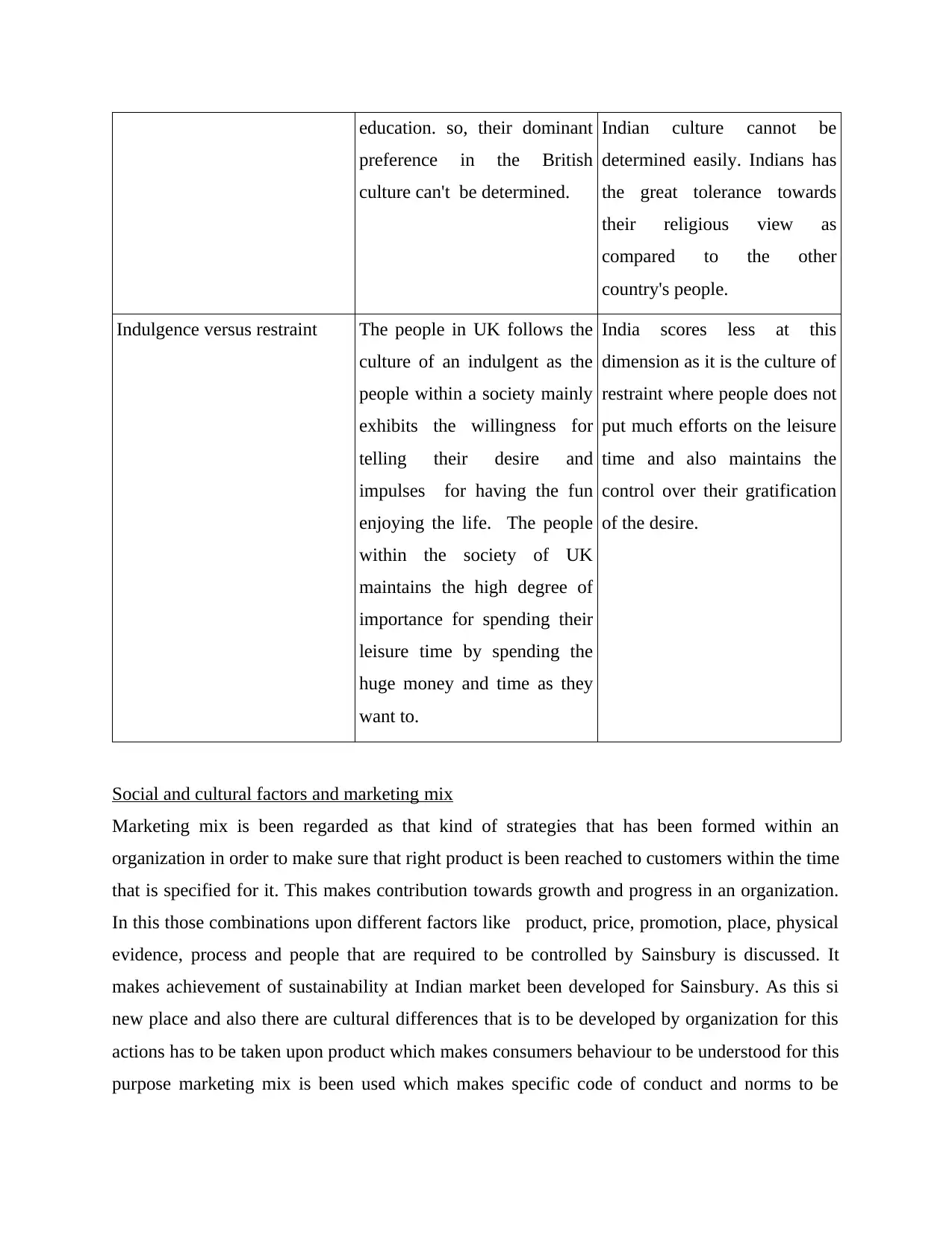
education. so, their dominant
preference in the British
culture can't be determined.
Indian culture cannot be
determined easily. Indians has
the great tolerance towards
their religious view as
compared to the other
country's people.
Indulgence versus restraint The people in UK follows the
culture of an indulgent as the
people within a society mainly
exhibits the willingness for
telling their desire and
impulses for having the fun
enjoying the life. The people
within the society of UK
maintains the high degree of
importance for spending their
leisure time by spending the
huge money and time as they
want to.
India scores less at this
dimension as it is the culture of
restraint where people does not
put much efforts on the leisure
time and also maintains the
control over their gratification
of the desire.
Social and cultural factors and marketing mix
Marketing mix is been regarded as that kind of strategies that has been formed within an
organization in order to make sure that right product is been reached to customers within the time
that is specified for it. This makes contribution towards growth and progress in an organization.
In this those combinations upon different factors like product, price, promotion, place, physical
evidence, process and people that are required to be controlled by Sainsbury is discussed. It
makes achievement of sustainability at Indian market been developed for Sainsbury. As this si
new place and also there are cultural differences that is to be developed by organization for this
actions has to be taken upon product which makes consumers behaviour to be understood for this
purpose marketing mix is been used which makes specific code of conduct and norms to be
preference in the British
culture can't be determined.
Indian culture cannot be
determined easily. Indians has
the great tolerance towards
their religious view as
compared to the other
country's people.
Indulgence versus restraint The people in UK follows the
culture of an indulgent as the
people within a society mainly
exhibits the willingness for
telling their desire and
impulses for having the fun
enjoying the life. The people
within the society of UK
maintains the high degree of
importance for spending their
leisure time by spending the
huge money and time as they
want to.
India scores less at this
dimension as it is the culture of
restraint where people does not
put much efforts on the leisure
time and also maintains the
control over their gratification
of the desire.
Social and cultural factors and marketing mix
Marketing mix is been regarded as that kind of strategies that has been formed within an
organization in order to make sure that right product is been reached to customers within the time
that is specified for it. This makes contribution towards growth and progress in an organization.
In this those combinations upon different factors like product, price, promotion, place, physical
evidence, process and people that are required to be controlled by Sainsbury is discussed. It
makes achievement of sustainability at Indian market been developed for Sainsbury. As this si
new place and also there are cultural differences that is to be developed by organization for this
actions has to be taken upon product which makes consumers behaviour to be understood for this
purpose marketing mix is been used which makes specific code of conduct and norms to be
⊘ This is a preview!⊘
Do you want full access?
Subscribe today to unlock all pages.

Trusted by 1+ million students worldwide
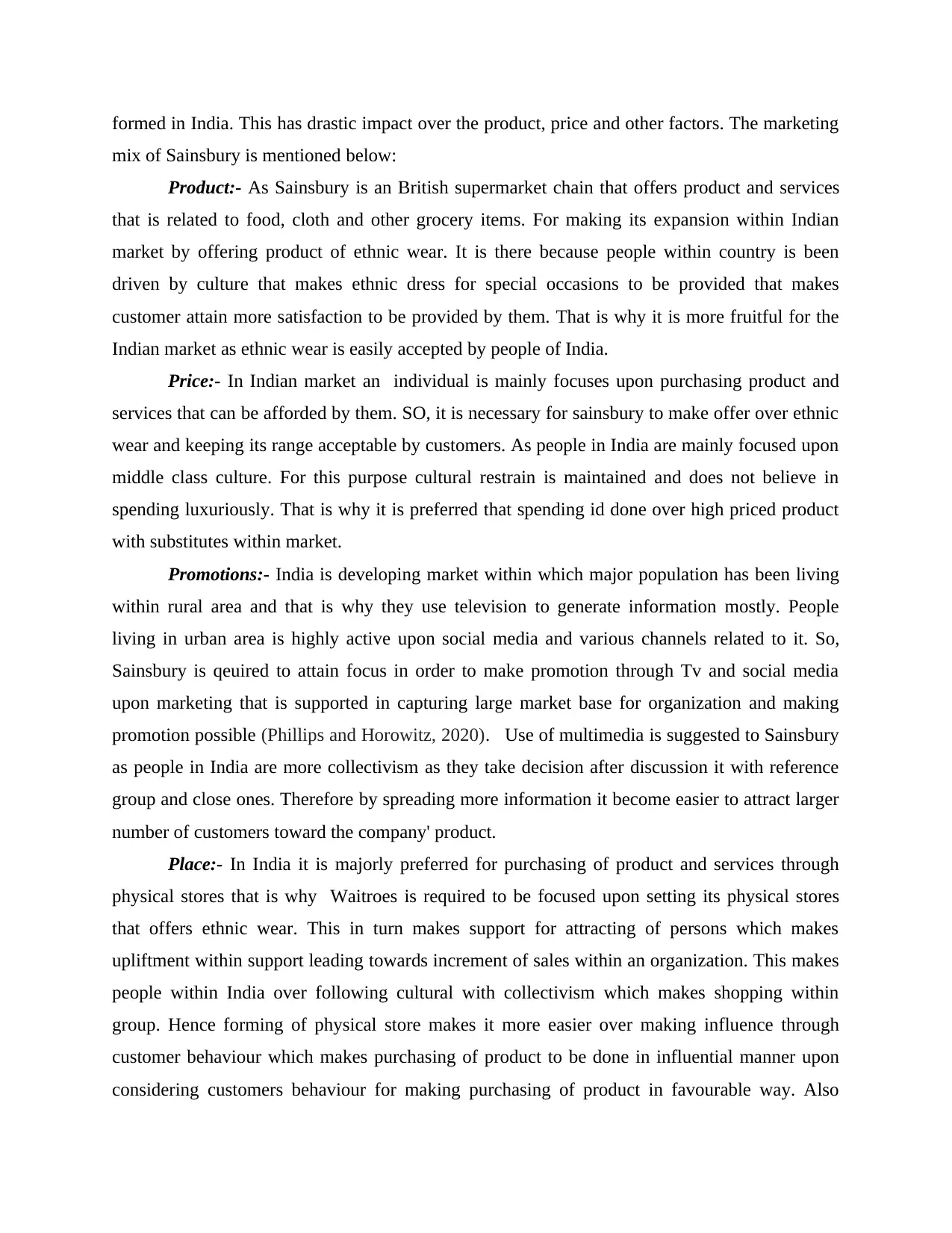
formed in India. This has drastic impact over the product, price and other factors. The marketing
mix of Sainsbury is mentioned below:
Product:- As Sainsbury is an British supermarket chain that offers product and services
that is related to food, cloth and other grocery items. For making its expansion within Indian
market by offering product of ethnic wear. It is there because people within country is been
driven by culture that makes ethnic dress for special occasions to be provided that makes
customer attain more satisfaction to be provided by them. That is why it is more fruitful for the
Indian market as ethnic wear is easily accepted by people of India.
Price:- In Indian market an individual is mainly focuses upon purchasing product and
services that can be afforded by them. SO, it is necessary for sainsbury to make offer over ethnic
wear and keeping its range acceptable by customers. As people in India are mainly focused upon
middle class culture. For this purpose cultural restrain is maintained and does not believe in
spending luxuriously. That is why it is preferred that spending id done over high priced product
with substitutes within market.
Promotions:- India is developing market within which major population has been living
within rural area and that is why they use television to generate information mostly. People
living in urban area is highly active upon social media and various channels related to it. So,
Sainsbury is qeuired to attain focus in order to make promotion through Tv and social media
upon marketing that is supported in capturing large market base for organization and making
promotion possible (Phillips and Horowitz, 2020). Use of multimedia is suggested to Sainsbury
as people in India are more collectivism as they take decision after discussion it with reference
group and close ones. Therefore by spreading more information it become easier to attract larger
number of customers toward the company' product.
Place:- In India it is majorly preferred for purchasing of product and services through
physical stores that is why Waitroes is required to be focused upon setting its physical stores
that offers ethnic wear. This in turn makes support for attracting of persons which makes
upliftment within support leading towards increment of sales within an organization. This makes
people within India over following cultural with collectivism which makes shopping within
group. Hence forming of physical store makes it more easier over making influence through
customer behaviour which makes purchasing of product to be done in influential manner upon
considering customers behaviour for making purchasing of product in favourable way. Also
mix of Sainsbury is mentioned below:
Product:- As Sainsbury is an British supermarket chain that offers product and services
that is related to food, cloth and other grocery items. For making its expansion within Indian
market by offering product of ethnic wear. It is there because people within country is been
driven by culture that makes ethnic dress for special occasions to be provided that makes
customer attain more satisfaction to be provided by them. That is why it is more fruitful for the
Indian market as ethnic wear is easily accepted by people of India.
Price:- In Indian market an individual is mainly focuses upon purchasing product and
services that can be afforded by them. SO, it is necessary for sainsbury to make offer over ethnic
wear and keeping its range acceptable by customers. As people in India are mainly focused upon
middle class culture. For this purpose cultural restrain is maintained and does not believe in
spending luxuriously. That is why it is preferred that spending id done over high priced product
with substitutes within market.
Promotions:- India is developing market within which major population has been living
within rural area and that is why they use television to generate information mostly. People
living in urban area is highly active upon social media and various channels related to it. So,
Sainsbury is qeuired to attain focus in order to make promotion through Tv and social media
upon marketing that is supported in capturing large market base for organization and making
promotion possible (Phillips and Horowitz, 2020). Use of multimedia is suggested to Sainsbury
as people in India are more collectivism as they take decision after discussion it with reference
group and close ones. Therefore by spreading more information it become easier to attract larger
number of customers toward the company' product.
Place:- In India it is majorly preferred for purchasing of product and services through
physical stores that is why Waitroes is required to be focused upon setting its physical stores
that offers ethnic wear. This in turn makes support for attracting of persons which makes
upliftment within support leading towards increment of sales within an organization. This makes
people within India over following cultural with collectivism which makes shopping within
group. Hence forming of physical store makes it more easier over making influence through
customer behaviour which makes purchasing of product to be done in influential manner upon
considering customers behaviour for making purchasing of product in favourable way. Also
Paraphrase This Document
Need a fresh take? Get an instant paraphrase of this document with our AI Paraphraser
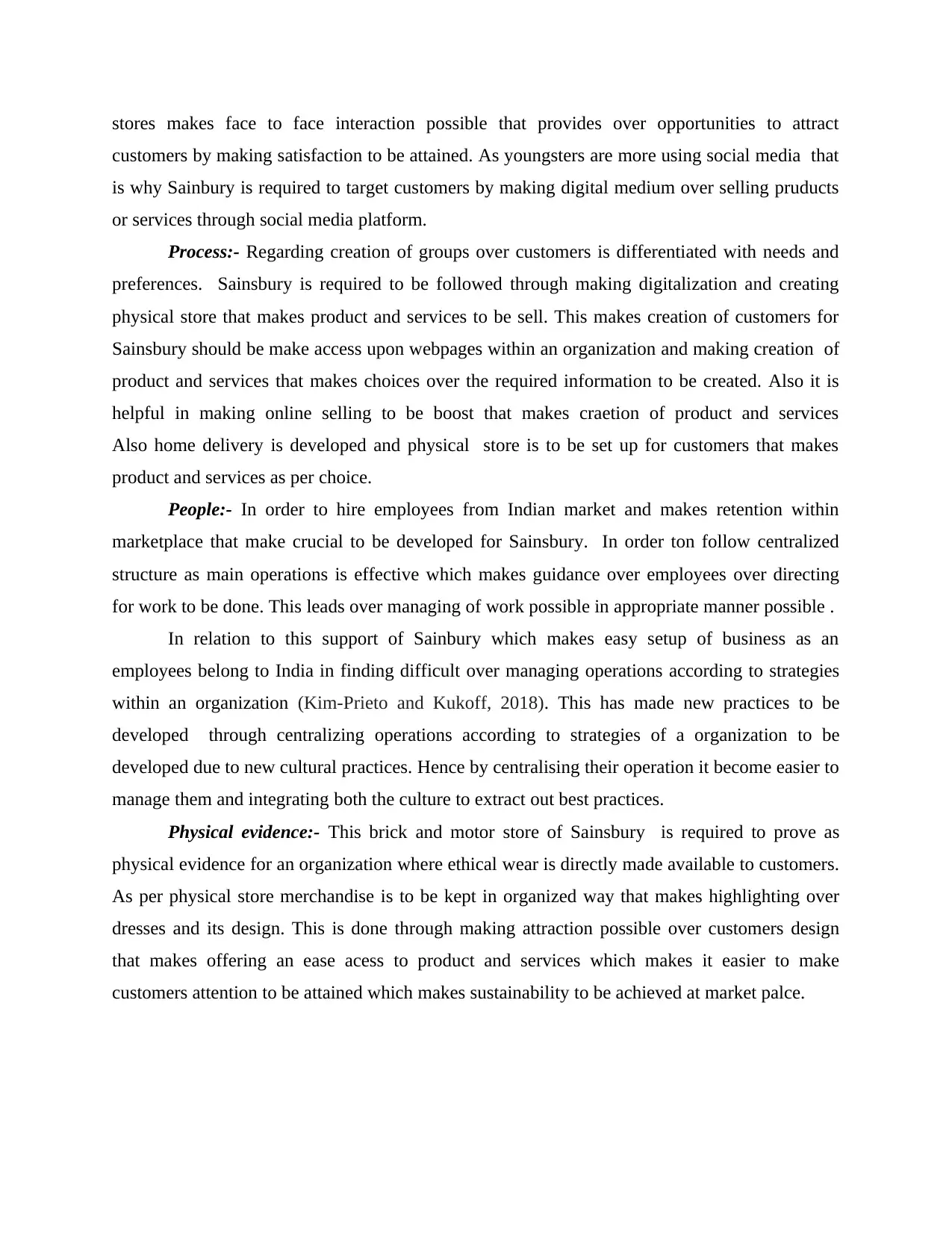
stores makes face to face interaction possible that provides over opportunities to attract
customers by making satisfaction to be attained. As youngsters are more using social media that
is why Sainbury is required to target customers by making digital medium over selling pruducts
or services through social media platform.
Process:- Regarding creation of groups over customers is differentiated with needs and
preferences. Sainsbury is required to be followed through making digitalization and creating
physical store that makes product and services to be sell. This makes creation of customers for
Sainsbury should be make access upon webpages within an organization and making creation of
product and services that makes choices over the required information to be created. Also it is
helpful in making online selling to be boost that makes craetion of product and services
Also home delivery is developed and physical store is to be set up for customers that makes
product and services as per choice.
People:- In order to hire employees from Indian market and makes retention within
marketplace that make crucial to be developed for Sainsbury. In order ton follow centralized
structure as main operations is effective which makes guidance over employees over directing
for work to be done. This leads over managing of work possible in appropriate manner possible .
In relation to this support of Sainbury which makes easy setup of business as an
employees belong to India in finding difficult over managing operations according to strategies
within an organization (Kim-Prieto and Kukoff, 2018). This has made new practices to be
developed through centralizing operations according to strategies of a organization to be
developed due to new cultural practices. Hence by centralising their operation it become easier to
manage them and integrating both the culture to extract out best practices.
Physical evidence:- This brick and motor store of Sainsbury is required to prove as
physical evidence for an organization where ethical wear is directly made available to customers.
As per physical store merchandise is to be kept in organized way that makes highlighting over
dresses and its design. This is done through making attraction possible over customers design
that makes offering an ease acess to product and services which makes it easier to make
customers attention to be attained which makes sustainability to be achieved at market palce.
customers by making satisfaction to be attained. As youngsters are more using social media that
is why Sainbury is required to target customers by making digital medium over selling pruducts
or services through social media platform.
Process:- Regarding creation of groups over customers is differentiated with needs and
preferences. Sainsbury is required to be followed through making digitalization and creating
physical store that makes product and services to be sell. This makes creation of customers for
Sainsbury should be make access upon webpages within an organization and making creation of
product and services that makes choices over the required information to be created. Also it is
helpful in making online selling to be boost that makes craetion of product and services
Also home delivery is developed and physical store is to be set up for customers that makes
product and services as per choice.
People:- In order to hire employees from Indian market and makes retention within
marketplace that make crucial to be developed for Sainsbury. In order ton follow centralized
structure as main operations is effective which makes guidance over employees over directing
for work to be done. This leads over managing of work possible in appropriate manner possible .
In relation to this support of Sainbury which makes easy setup of business as an
employees belong to India in finding difficult over managing operations according to strategies
within an organization (Kim-Prieto and Kukoff, 2018). This has made new practices to be
developed through centralizing operations according to strategies of a organization to be
developed due to new cultural practices. Hence by centralising their operation it become easier to
manage them and integrating both the culture to extract out best practices.
Physical evidence:- This brick and motor store of Sainsbury is required to prove as
physical evidence for an organization where ethical wear is directly made available to customers.
As per physical store merchandise is to be kept in organized way that makes highlighting over
dresses and its design. This is done through making attraction possible over customers design
that makes offering an ease acess to product and services which makes it easier to make
customers attention to be attained which makes sustainability to be achieved at market palce.
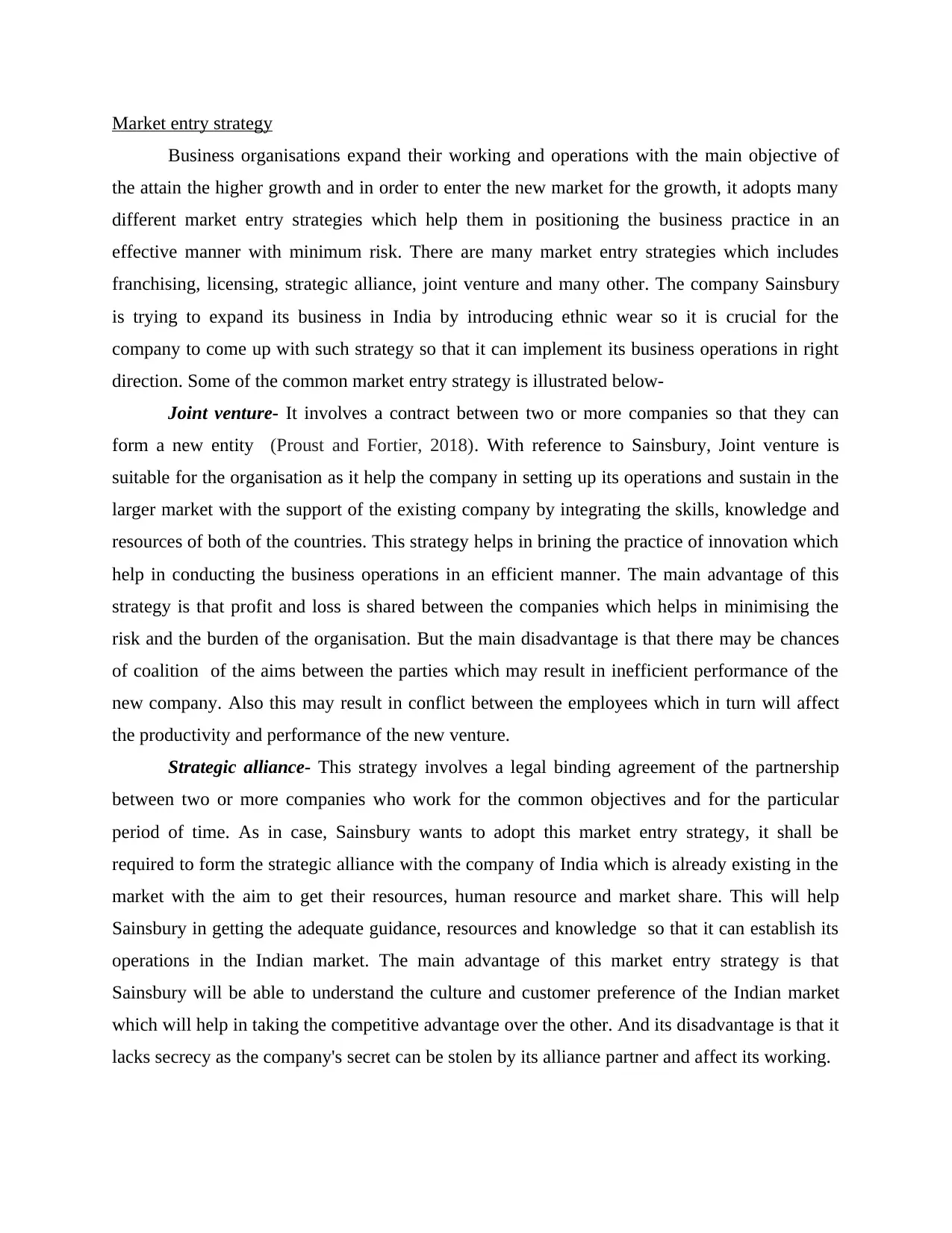
Market entry strategy
Business organisations expand their working and operations with the main objective of
the attain the higher growth and in order to enter the new market for the growth, it adopts many
different market entry strategies which help them in positioning the business practice in an
effective manner with minimum risk. There are many market entry strategies which includes
franchising, licensing, strategic alliance, joint venture and many other. The company Sainsbury
is trying to expand its business in India by introducing ethnic wear so it is crucial for the
company to come up with such strategy so that it can implement its business operations in right
direction. Some of the common market entry strategy is illustrated below-
Joint venture- It involves a contract between two or more companies so that they can
form a new entity (Proust and Fortier, 2018). With reference to Sainsbury, Joint venture is
suitable for the organisation as it help the company in setting up its operations and sustain in the
larger market with the support of the existing company by integrating the skills, knowledge and
resources of both of the countries. This strategy helps in brining the practice of innovation which
help in conducting the business operations in an efficient manner. The main advantage of this
strategy is that profit and loss is shared between the companies which helps in minimising the
risk and the burden of the organisation. But the main disadvantage is that there may be chances
of coalition of the aims between the parties which may result in inefficient performance of the
new company. Also this may result in conflict between the employees which in turn will affect
the productivity and performance of the new venture.
Strategic alliance- This strategy involves a legal binding agreement of the partnership
between two or more companies who work for the common objectives and for the particular
period of time. As in case, Sainsbury wants to adopt this market entry strategy, it shall be
required to form the strategic alliance with the company of India which is already existing in the
market with the aim to get their resources, human resource and market share. This will help
Sainsbury in getting the adequate guidance, resources and knowledge so that it can establish its
operations in the Indian market. The main advantage of this market entry strategy is that
Sainsbury will be able to understand the culture and customer preference of the Indian market
which will help in taking the competitive advantage over the other. And its disadvantage is that it
lacks secrecy as the company's secret can be stolen by its alliance partner and affect its working.
Business organisations expand their working and operations with the main objective of
the attain the higher growth and in order to enter the new market for the growth, it adopts many
different market entry strategies which help them in positioning the business practice in an
effective manner with minimum risk. There are many market entry strategies which includes
franchising, licensing, strategic alliance, joint venture and many other. The company Sainsbury
is trying to expand its business in India by introducing ethnic wear so it is crucial for the
company to come up with such strategy so that it can implement its business operations in right
direction. Some of the common market entry strategy is illustrated below-
Joint venture- It involves a contract between two or more companies so that they can
form a new entity (Proust and Fortier, 2018). With reference to Sainsbury, Joint venture is
suitable for the organisation as it help the company in setting up its operations and sustain in the
larger market with the support of the existing company by integrating the skills, knowledge and
resources of both of the countries. This strategy helps in brining the practice of innovation which
help in conducting the business operations in an efficient manner. The main advantage of this
strategy is that profit and loss is shared between the companies which helps in minimising the
risk and the burden of the organisation. But the main disadvantage is that there may be chances
of coalition of the aims between the parties which may result in inefficient performance of the
new company. Also this may result in conflict between the employees which in turn will affect
the productivity and performance of the new venture.
Strategic alliance- This strategy involves a legal binding agreement of the partnership
between two or more companies who work for the common objectives and for the particular
period of time. As in case, Sainsbury wants to adopt this market entry strategy, it shall be
required to form the strategic alliance with the company of India which is already existing in the
market with the aim to get their resources, human resource and market share. This will help
Sainsbury in getting the adequate guidance, resources and knowledge so that it can establish its
operations in the Indian market. The main advantage of this market entry strategy is that
Sainsbury will be able to understand the culture and customer preference of the Indian market
which will help in taking the competitive advantage over the other. And its disadvantage is that it
lacks secrecy as the company's secret can be stolen by its alliance partner and affect its working.
⊘ This is a preview!⊘
Do you want full access?
Subscribe today to unlock all pages.

Trusted by 1+ million students worldwide
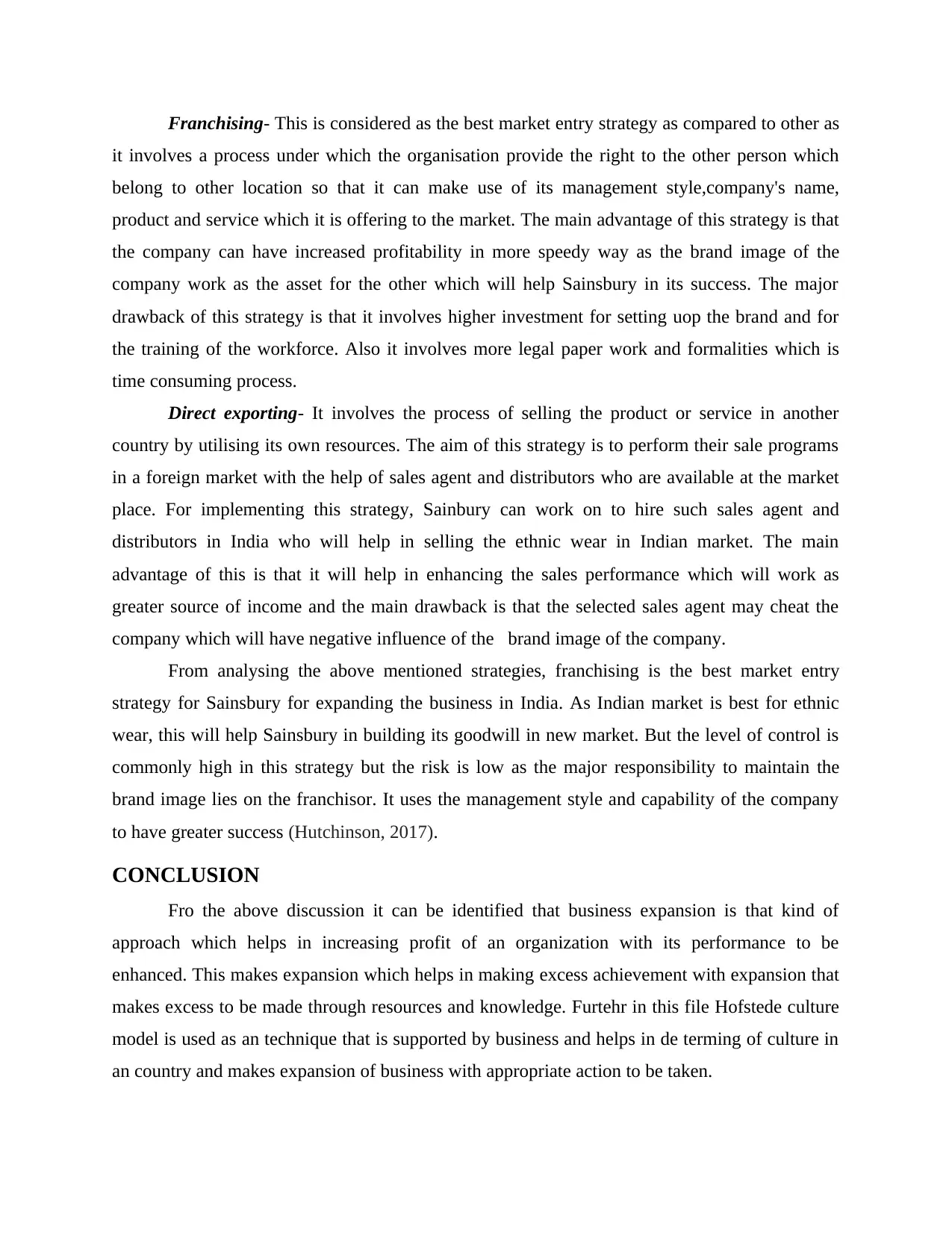
Franchising- This is considered as the best market entry strategy as compared to other as
it involves a process under which the organisation provide the right to the other person which
belong to other location so that it can make use of its management style,company's name,
product and service which it is offering to the market. The main advantage of this strategy is that
the company can have increased profitability in more speedy way as the brand image of the
company work as the asset for the other which will help Sainsbury in its success. The major
drawback of this strategy is that it involves higher investment for setting uop the brand and for
the training of the workforce. Also it involves more legal paper work and formalities which is
time consuming process.
Direct exporting- It involves the process of selling the product or service in another
country by utilising its own resources. The aim of this strategy is to perform their sale programs
in a foreign market with the help of sales agent and distributors who are available at the market
place. For implementing this strategy, Sainbury can work on to hire such sales agent and
distributors in India who will help in selling the ethnic wear in Indian market. The main
advantage of this is that it will help in enhancing the sales performance which will work as
greater source of income and the main drawback is that the selected sales agent may cheat the
company which will have negative influence of the brand image of the company.
From analysing the above mentioned strategies, franchising is the best market entry
strategy for Sainsbury for expanding the business in India. As Indian market is best for ethnic
wear, this will help Sainsbury in building its goodwill in new market. But the level of control is
commonly high in this strategy but the risk is low as the major responsibility to maintain the
brand image lies on the franchisor. It uses the management style and capability of the company
to have greater success (Hutchinson, 2017).
CONCLUSION
Fro the above discussion it can be identified that business expansion is that kind of
approach which helps in increasing profit of an organization with its performance to be
enhanced. This makes expansion which helps in making excess achievement with expansion that
makes excess to be made through resources and knowledge. Furtehr in this file Hofstede culture
model is used as an technique that is supported by business and helps in de terming of culture in
an country and makes expansion of business with appropriate action to be taken.
it involves a process under which the organisation provide the right to the other person which
belong to other location so that it can make use of its management style,company's name,
product and service which it is offering to the market. The main advantage of this strategy is that
the company can have increased profitability in more speedy way as the brand image of the
company work as the asset for the other which will help Sainsbury in its success. The major
drawback of this strategy is that it involves higher investment for setting uop the brand and for
the training of the workforce. Also it involves more legal paper work and formalities which is
time consuming process.
Direct exporting- It involves the process of selling the product or service in another
country by utilising its own resources. The aim of this strategy is to perform their sale programs
in a foreign market with the help of sales agent and distributors who are available at the market
place. For implementing this strategy, Sainbury can work on to hire such sales agent and
distributors in India who will help in selling the ethnic wear in Indian market. The main
advantage of this is that it will help in enhancing the sales performance which will work as
greater source of income and the main drawback is that the selected sales agent may cheat the
company which will have negative influence of the brand image of the company.
From analysing the above mentioned strategies, franchising is the best market entry
strategy for Sainsbury for expanding the business in India. As Indian market is best for ethnic
wear, this will help Sainsbury in building its goodwill in new market. But the level of control is
commonly high in this strategy but the risk is low as the major responsibility to maintain the
brand image lies on the franchisor. It uses the management style and capability of the company
to have greater success (Hutchinson, 2017).
CONCLUSION
Fro the above discussion it can be identified that business expansion is that kind of
approach which helps in increasing profit of an organization with its performance to be
enhanced. This makes expansion which helps in making excess achievement with expansion that
makes excess to be made through resources and knowledge. Furtehr in this file Hofstede culture
model is used as an technique that is supported by business and helps in de terming of culture in
an country and makes expansion of business with appropriate action to be taken.
Paraphrase This Document
Need a fresh take? Get an instant paraphrase of this document with our AI Paraphraser
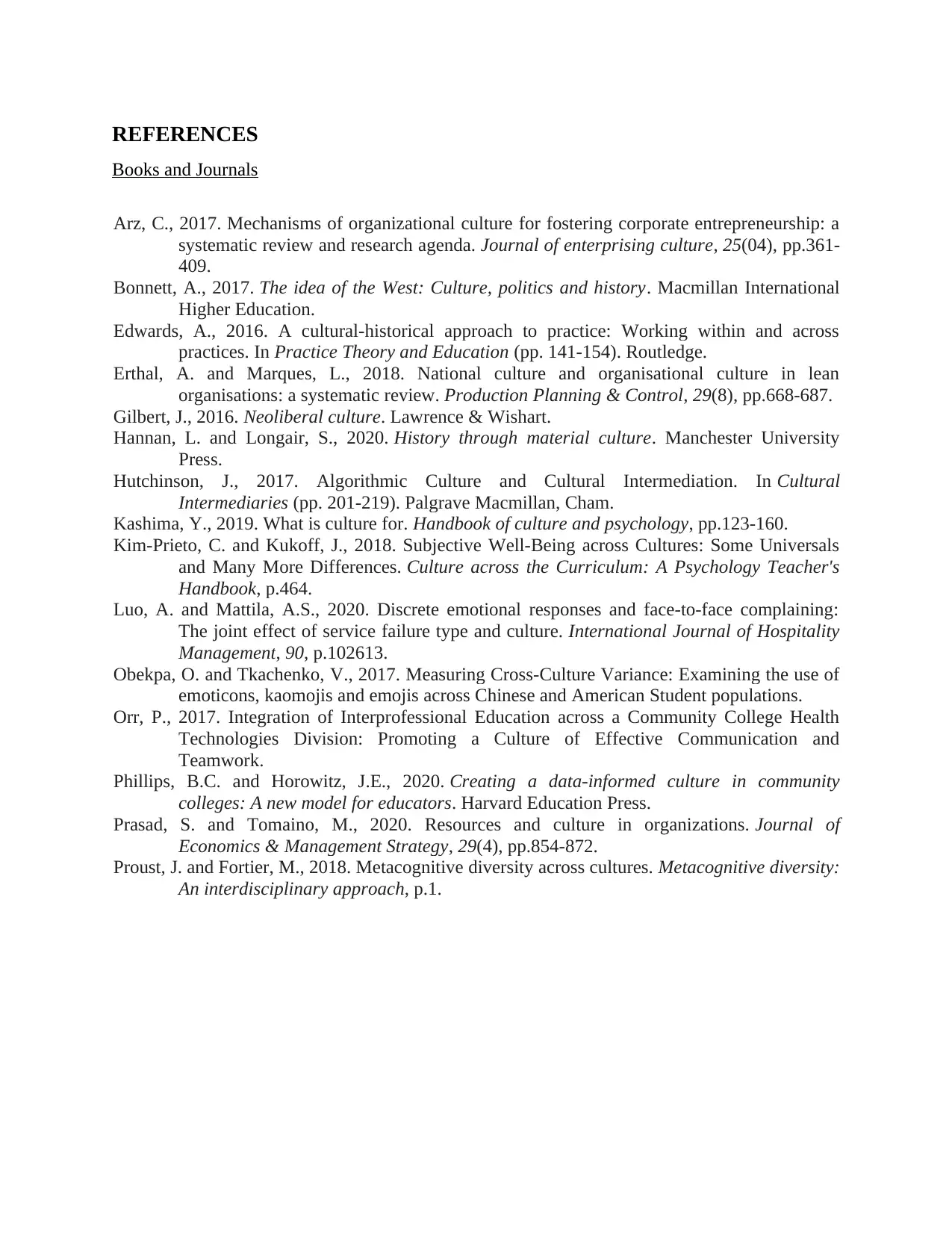
REFERENCES
Books and Journals
Arz, C., 2017. Mechanisms of organizational culture for fostering corporate entrepreneurship: a
systematic review and research agenda. Journal of enterprising culture, 25(04), pp.361-
409.
Bonnett, A., 2017. The idea of the West: Culture, politics and history. Macmillan International
Higher Education.
Edwards, A., 2016. A cultural-historical approach to practice: Working within and across
practices. In Practice Theory and Education (pp. 141-154). Routledge.
Erthal, A. and Marques, L., 2018. National culture and organisational culture in lean
organisations: a systematic review. Production Planning & Control, 29(8), pp.668-687.
Gilbert, J., 2016. Neoliberal culture. Lawrence & Wishart.
Hannan, L. and Longair, S., 2020. History through material culture. Manchester University
Press.
Hutchinson, J., 2017. Algorithmic Culture and Cultural Intermediation. In Cultural
Intermediaries (pp. 201-219). Palgrave Macmillan, Cham.
Kashima, Y., 2019. What is culture for. Handbook of culture and psychology, pp.123-160.
Kim-Prieto, C. and Kukoff, J., 2018. Subjective Well-Being across Cultures: Some Universals
and Many More Differences. Culture across the Curriculum: A Psychology Teacher's
Handbook, p.464.
Luo, A. and Mattila, A.S., 2020. Discrete emotional responses and face-to-face complaining:
The joint effect of service failure type and culture. International Journal of Hospitality
Management, 90, p.102613.
Obekpa, O. and Tkachenko, V., 2017. Measuring Cross-Culture Variance: Examining the use of
emoticons, kaomojis and emojis across Chinese and American Student populations.
Orr, P., 2017. Integration of Interprofessional Education across a Community College Health
Technologies Division: Promoting a Culture of Effective Communication and
Teamwork.
Phillips, B.C. and Horowitz, J.E., 2020. Creating a data-informed culture in community
colleges: A new model for educators. Harvard Education Press.
Prasad, S. and Tomaino, M., 2020. Resources and culture in organizations. Journal of
Economics & Management Strategy, 29(4), pp.854-872.
Proust, J. and Fortier, M., 2018. Metacognitive diversity across cultures. Metacognitive diversity:
An interdisciplinary approach, p.1.
Books and Journals
Arz, C., 2017. Mechanisms of organizational culture for fostering corporate entrepreneurship: a
systematic review and research agenda. Journal of enterprising culture, 25(04), pp.361-
409.
Bonnett, A., 2017. The idea of the West: Culture, politics and history. Macmillan International
Higher Education.
Edwards, A., 2016. A cultural-historical approach to practice: Working within and across
practices. In Practice Theory and Education (pp. 141-154). Routledge.
Erthal, A. and Marques, L., 2018. National culture and organisational culture in lean
organisations: a systematic review. Production Planning & Control, 29(8), pp.668-687.
Gilbert, J., 2016. Neoliberal culture. Lawrence & Wishart.
Hannan, L. and Longair, S., 2020. History through material culture. Manchester University
Press.
Hutchinson, J., 2017. Algorithmic Culture and Cultural Intermediation. In Cultural
Intermediaries (pp. 201-219). Palgrave Macmillan, Cham.
Kashima, Y., 2019. What is culture for. Handbook of culture and psychology, pp.123-160.
Kim-Prieto, C. and Kukoff, J., 2018. Subjective Well-Being across Cultures: Some Universals
and Many More Differences. Culture across the Curriculum: A Psychology Teacher's
Handbook, p.464.
Luo, A. and Mattila, A.S., 2020. Discrete emotional responses and face-to-face complaining:
The joint effect of service failure type and culture. International Journal of Hospitality
Management, 90, p.102613.
Obekpa, O. and Tkachenko, V., 2017. Measuring Cross-Culture Variance: Examining the use of
emoticons, kaomojis and emojis across Chinese and American Student populations.
Orr, P., 2017. Integration of Interprofessional Education across a Community College Health
Technologies Division: Promoting a Culture of Effective Communication and
Teamwork.
Phillips, B.C. and Horowitz, J.E., 2020. Creating a data-informed culture in community
colleges: A new model for educators. Harvard Education Press.
Prasad, S. and Tomaino, M., 2020. Resources and culture in organizations. Journal of
Economics & Management Strategy, 29(4), pp.854-872.
Proust, J. and Fortier, M., 2018. Metacognitive diversity across cultures. Metacognitive diversity:
An interdisciplinary approach, p.1.

⊘ This is a preview!⊘
Do you want full access?
Subscribe today to unlock all pages.

Trusted by 1+ million students worldwide
1 out of 13
Related Documents
Your All-in-One AI-Powered Toolkit for Academic Success.
+13062052269
info@desklib.com
Available 24*7 on WhatsApp / Email
![[object Object]](/_next/static/media/star-bottom.7253800d.svg)
Unlock your academic potential
Copyright © 2020–2025 A2Z Services. All Rights Reserved. Developed and managed by ZUCOL.





